Frankfurt am Main might be known as Germany’s financial capital, but there’s so much more to this beautiful city along the Main River than that! Learn all about Frankfurt’s “New” Old Town in this detailed guide, including the top things to do and see, where to eat, and my tips for making the most of your visit.
This post contains affiliate links, from which we may receive a commission. You can read our full affiliate disclosure here.
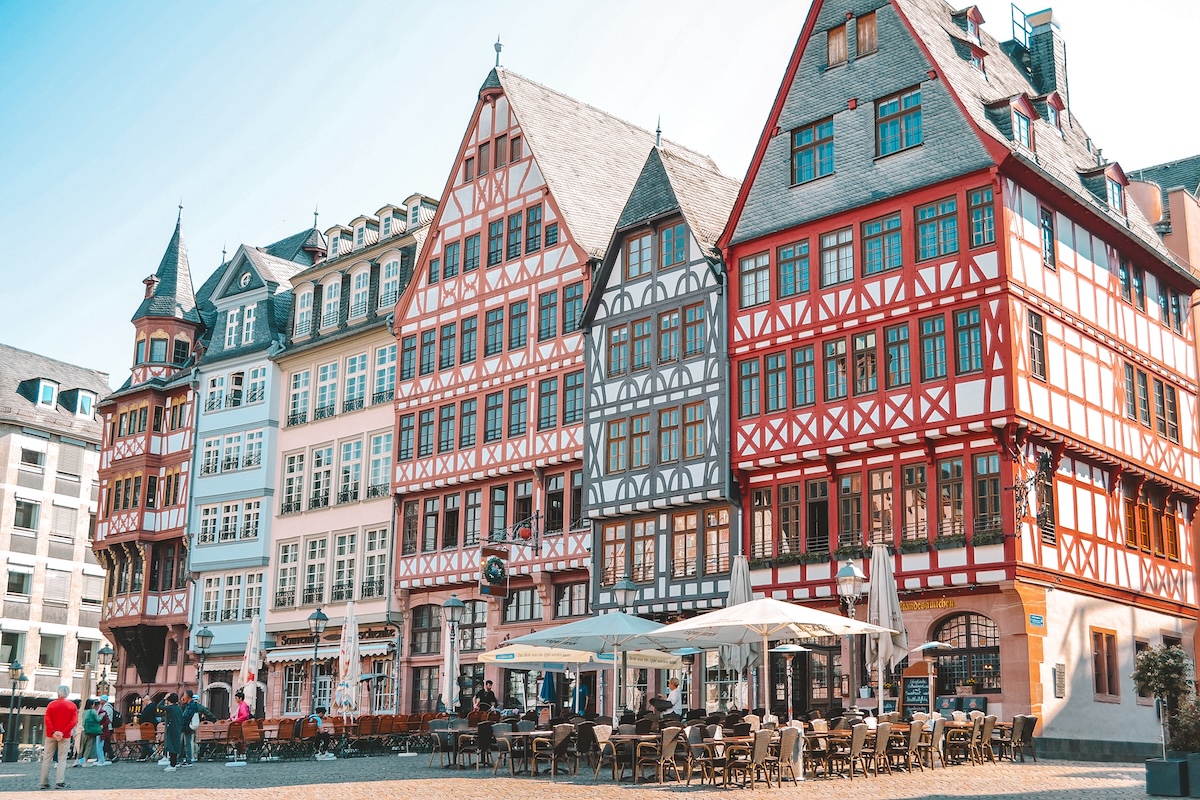
As one of the most important financial hubs in all of Europe, it’s no wonder that most people associate Frankfurt with its “Mainhattan” banking district full of soaring skyscrapers.
However, there’s so much more to Frankfurt am Main than that! The city has a rich history stretching all the way back to the 1st Century, and it’s provided the backdrop for some of the most significant moments in German history — including the birth of the writer and philosopher Johann Wolfgang von Goethe and the foundation of the first freely elected German parliament.
To learn all about Frankfurt am Main’s history (and see some of the city’s prettiest buildings, to boot!), you need to leave the banking district and head to the “New” Old Town.
Below is a detailed overview of the best things to do in Frankfurt’s “New” Old Town, including cute cafes, beautiful churches, interesting museums, and more!
~Claire
How to Get From the Central Station to the New Old Town
Getting to Frankfurt’s New Old Town attractions from the central train station is quick and easy! I suggest beginning your visit at the historic St. Paul’s Church, so that’s where the instructions below take you. The Römerberg and tourist information center are nearby.
- On foot: Takes 20 minutes. Exit from the main entrance of the central train station. Walk down Kaiserstraße until you reach Kaiserplatz (take a photo in front of the giant Euro sculpture en route!). Turn right on Bethmannstraße, then take the first right onto Berliner Straße. St. Paul’s Church — and past it, the Römerberg — will be on the right side.
- Via public transportation: Takes 10 minutes. Ride tram #11 or #14 towards the city center. Get off at “Frankfurt (Main) Römer/Paulskirche.” Don’t forget to purchase a tram ticket before boarding!
Why Is It Called the “New” Old Town?
Confused by the name? Before World War II, Frankfurt had one of the largest preserved medieval centers in Germany! This area once boasted more than 1,200 half-timbered buildings.
In 1944, an air raid destroyed the medieval Old Town and the area was left relatively untouched until 2012. At that point, the city began rebuilding a tiny portion of Frankfurt’s original Old Town. In 2018, the building work was completed.
Thus, the heart of the original Old Town was rebuilt and Frankfurt’s “New” Old Town was born.
Attractions in the New Old Town (in Walking Order)
Because you’re my favorite readers on the Internet, I’ve listed the top attractions in Frankfurt’s New Old town in walking order so you can take yourself on a self-guided walking tour.
With that said, I grouped all of the museums together at the very end of this post for ease of reference since you likely won’t want to visit every single museum in the New Old Town.
Paulskirche (St. Paul’s Church)
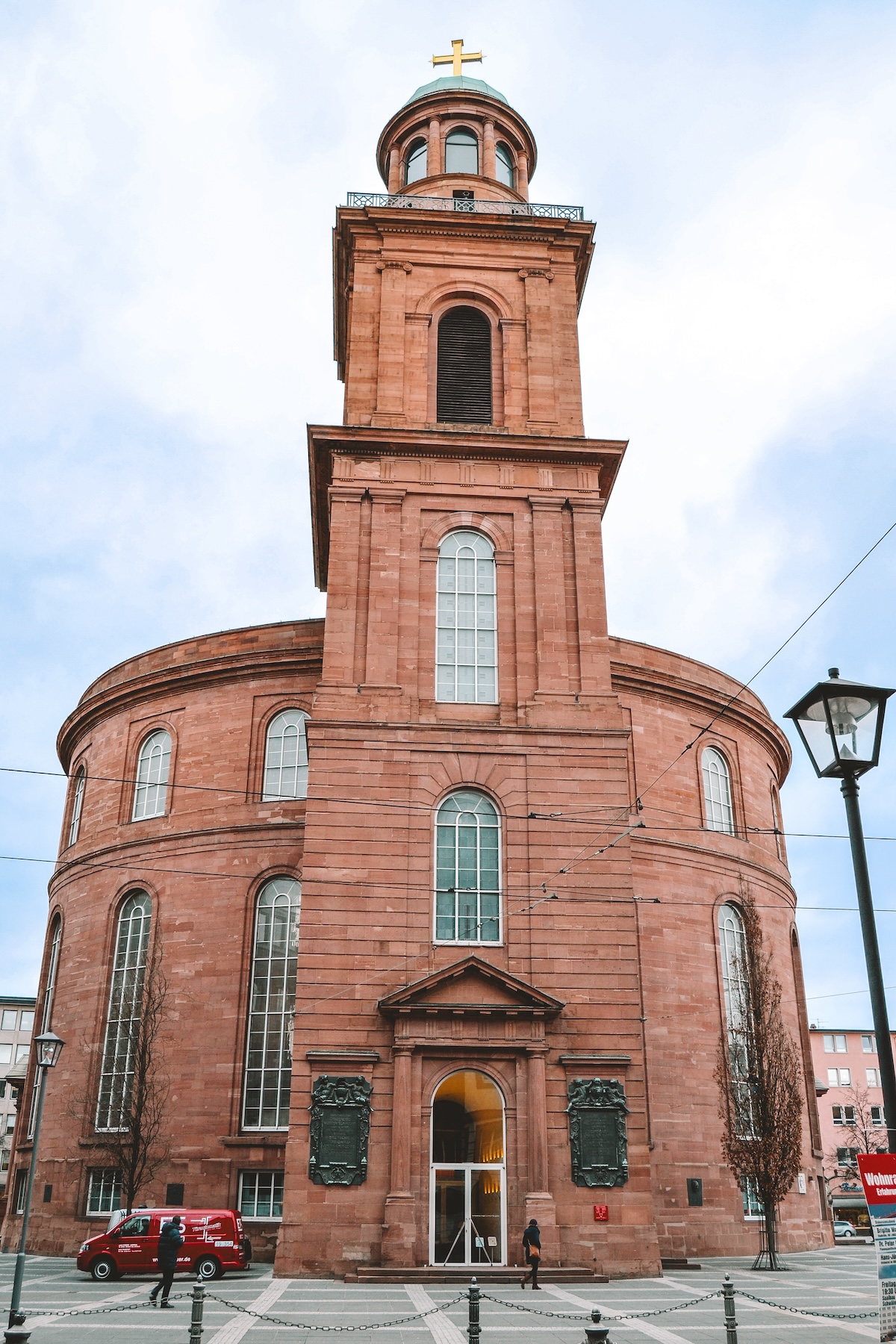
Once one of Frankfurt’s most important churches, St. Paul’s Church hasn’t been used for religious purposes in about 70 years.
The unique red sandstone church was the site of the Germany’s first National Assembly. It was here that the country’s first freely elected parliament convened to draft a democratic constitution in May 1848.
Like the rest of the New Old Town, St. Paul’s Church was destroyed in WWII. It was rebuilt in 1948 to celebrate the 100th anniversary of the first National Assembly.
The interior of the church now serves as an exhibition space. Pop inside to see the free permanent exhibit titled “St. Paul’s Church. Symbol of Democratic Freedom and National Unity.”
Römerberg
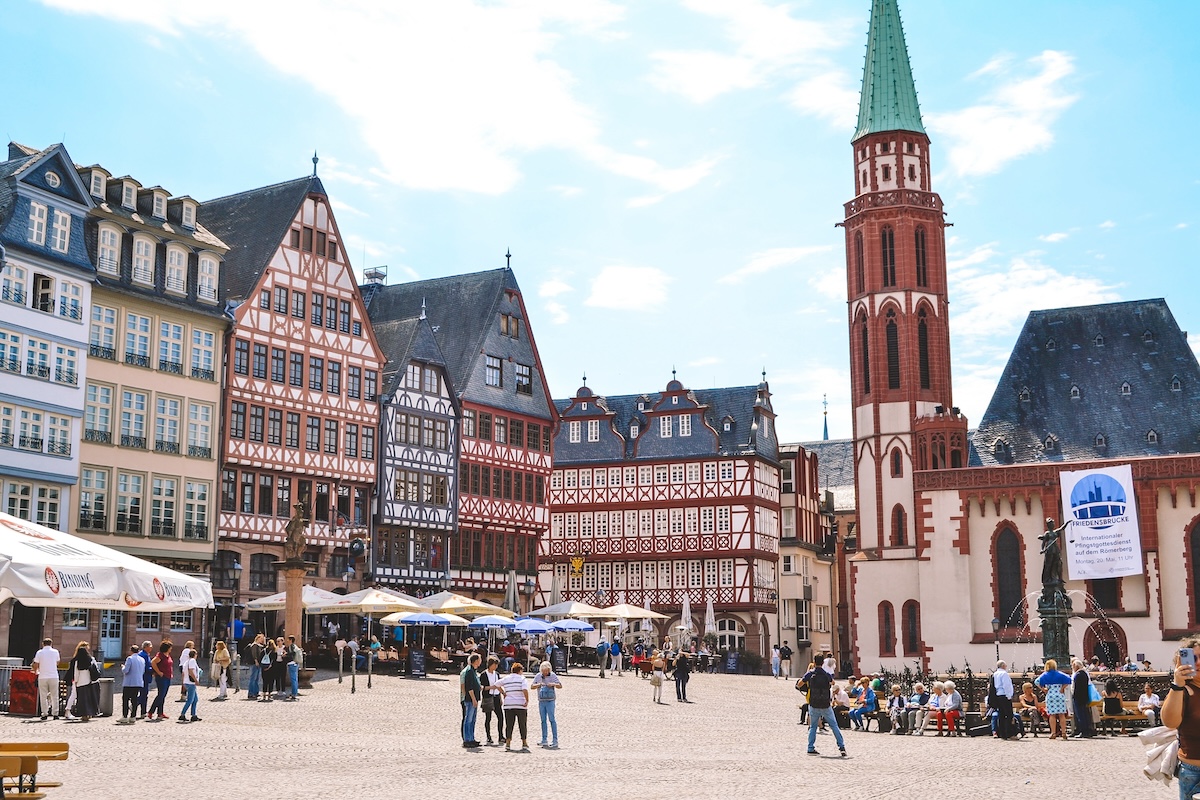
Nestled in the very heart of the New Old Town, the Römerberg is one of the must-see attractions in Frankfurt am Main. This gorgeous square has been the seat of the city council (called the Römer) since the 15th Century and is what gave this spot its name.
Look for the Fountain of Justice in the center of the Römerberg. Nearby, you’ll find a plaque in the cobblestones that commemorates the Nazi book burnings that took place here in 1933.
One side of the Römerberg is dominated by stunning reconstructed half-timbered houses, and on the other side lies the city hall, called the Römer (more details below).
Römerberg: Römer
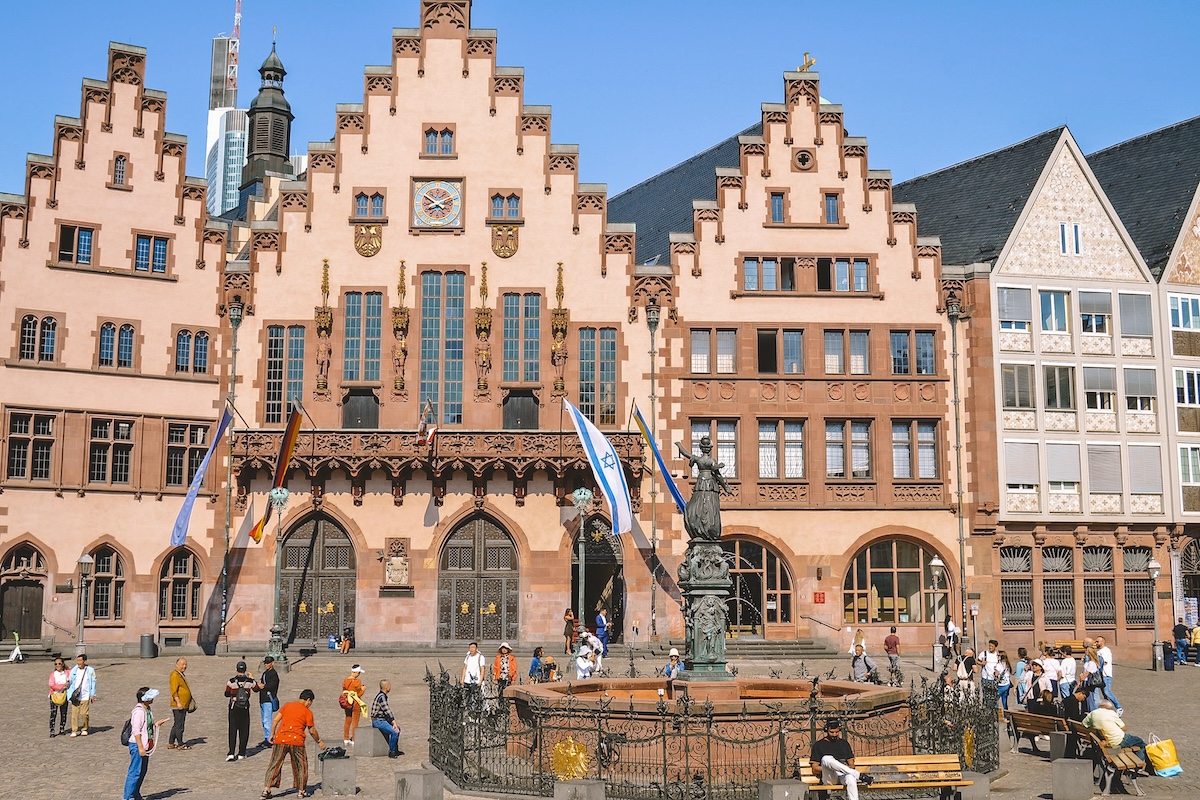
While exploring the Römerberg, your eyes can’t help but wander time and again to the stunning three-gabled city hall (helpfully called the Römer).
The distinctive building was purchased in 1405 and has acted as the city hall all these years.
Take care to admire the Römer’s balcony; it’s welcomed many famous visitors over the years, including Queen Elizabeth II of England!
Römerberg: Alte Nikolaikirche (Old St. Nicholas Church)
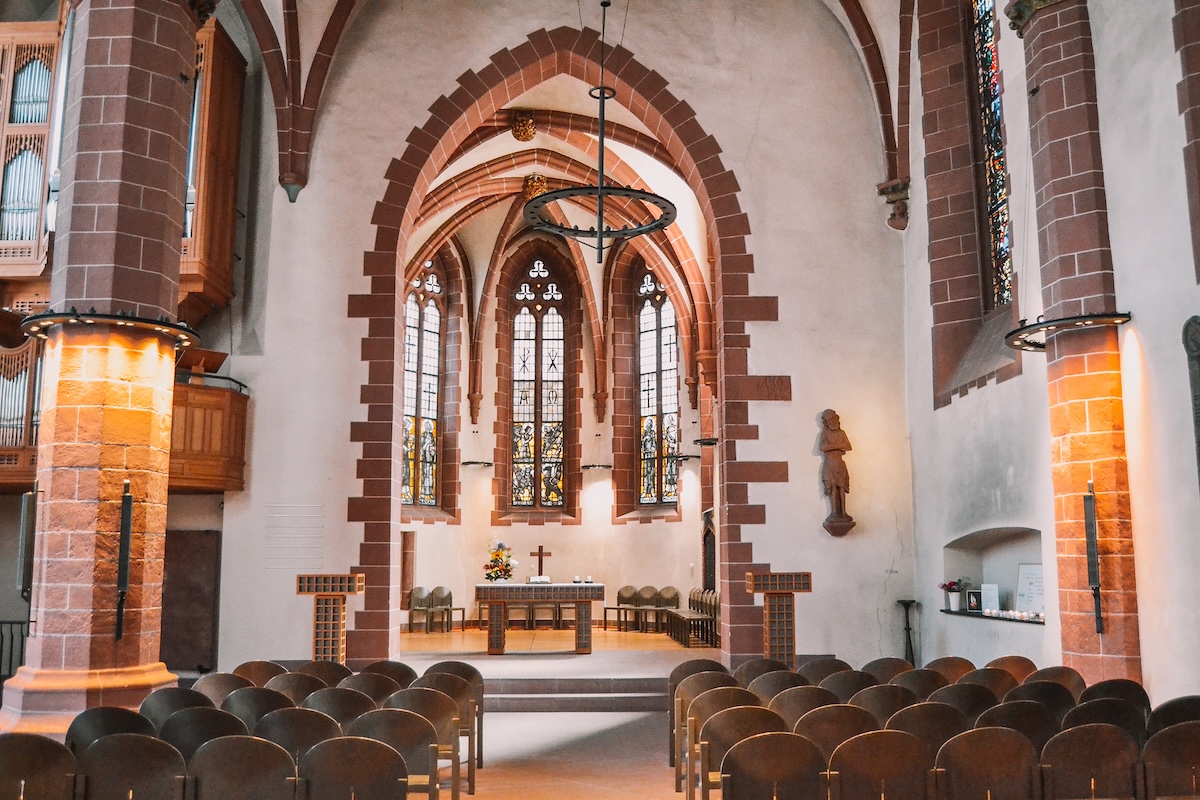
For a glimpse of what Frankfurt’s medieval Old Town would have looked like, enter the Old St. Nicholas Church on the Römerberg.
The first written records of the church date back to 1264, but historians believe that Old St. Nicholas is even older than that.
It’s a beautiful Gothic-style church with a simple interior that includes two aisles. Enjoy a moment of silence before continuing your explorations of Frankfurt’s New Old Town.
Eiserner Steg (Iron Footbridge)
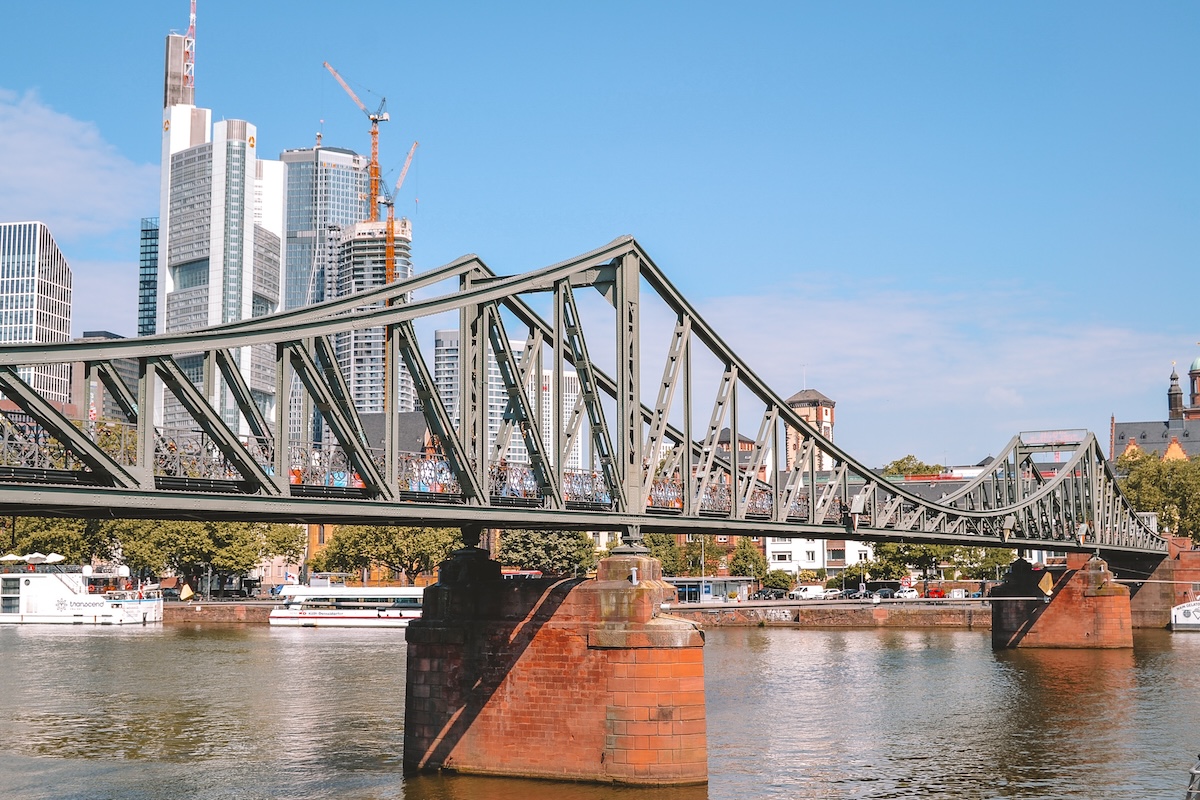
The Eiserner Steg is a picturesque footbridge that connects the New Old Town with the Sachsenhausen neighborhood. As you cross the Main River, look for the many love locks that have been attached to the railings.
From the footbridge, you have a fantastic view of the “Mainhattan” skyline, a nickname for Frankfurt’s banking district. This is one of the few places in Germany that you can see actual skyscrapers!
Hühnermarkt
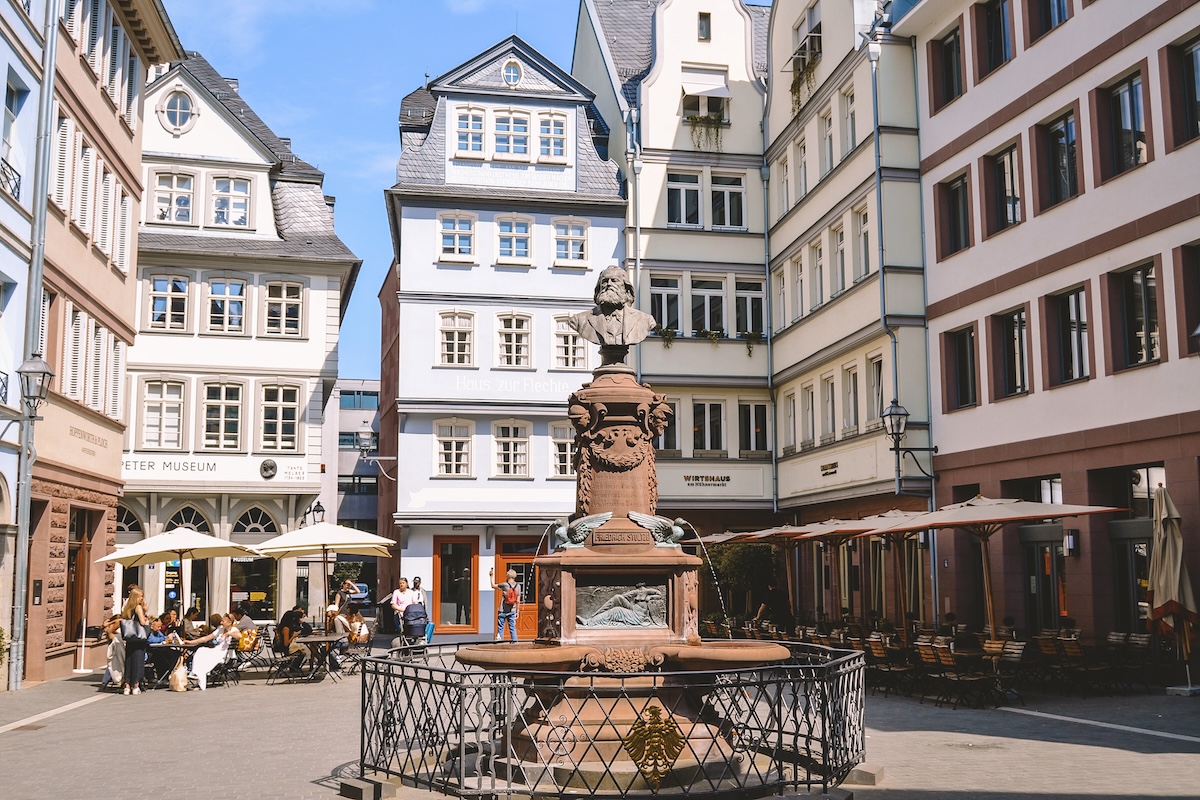
Literally translated, this was the city’s old chicken market. It’s located in the center of the New Old Town and makes for a pretty photo op. There’s not much to do or see around this small square, but it’s so pretty I had to mention it!
Kaiserdom (Frankfurt Cathedral)
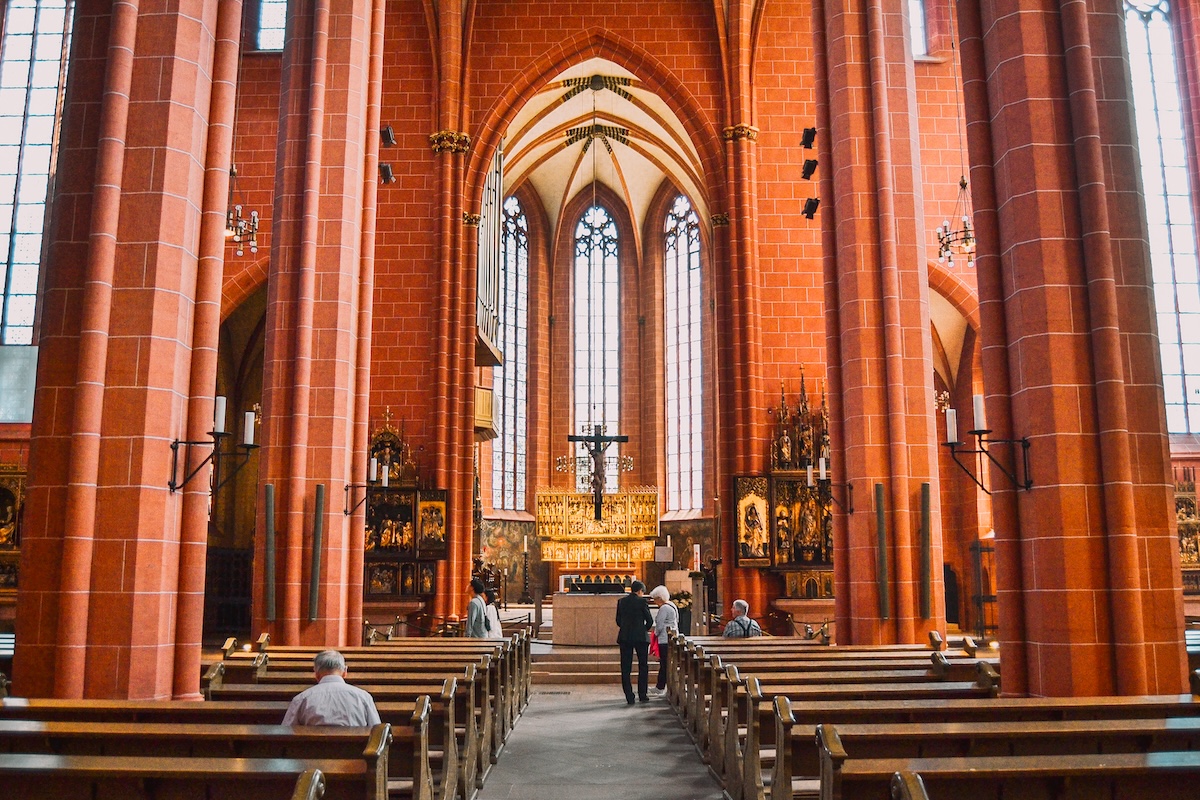
Officially called St. Bartholomew’s Cathedral after one of Jesus’ twelve disciples, the Frankfurt Cathedral was built in the Gothic style between 1315 and 1358.
Inside the cathedral, there’s a reliquary containing what’s believed to be a piece of St. Bartholomew’s skull. It’s unknown when exactly St. Bartholomew died, but it’s known that he was flayed and beheaded at the behest of the Armenian King Astyages.
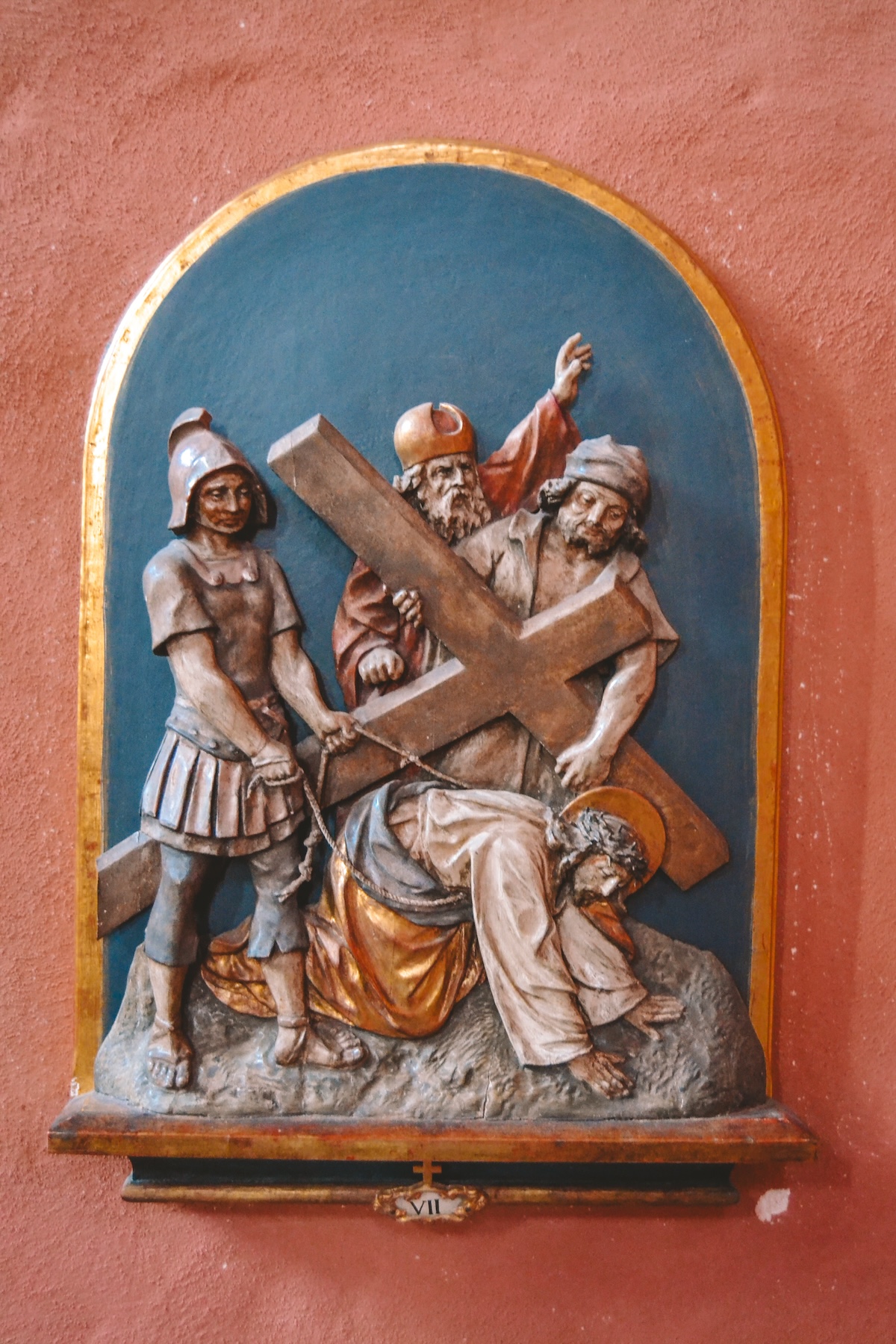
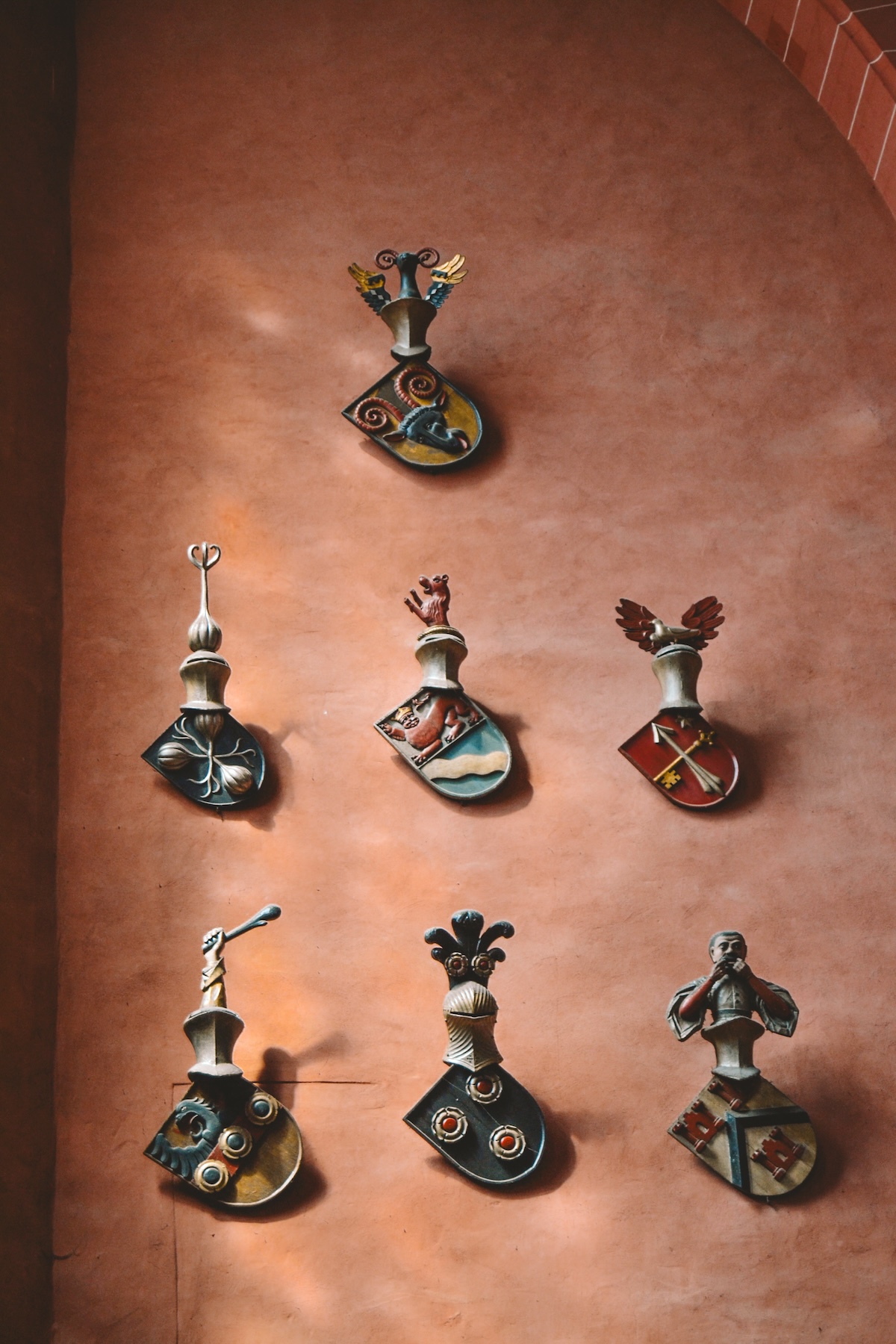
Like many buildings in the New Old Town, the Frankfurt Cathedral has been the site of some of Frankfurt’s most important events. In 1356, Emperor Charles IV made Frankfurt the site of German royal elections. As such, 10 German emperors and kings of the Holy Roman Empire were either elected or crowned within this cathedral.
On a quirkier note, the cathedral also boasts the second heaviest bell in all of Germany, called Gloriosa (it weighs nearly 12,000 kg!).
Claire’s Tip: For a small fee, you can climb the 328 steps to the top of the cathedral tower for a view of Frankfurt am Main from above.
Kleinmarkthalle (Market Hall)
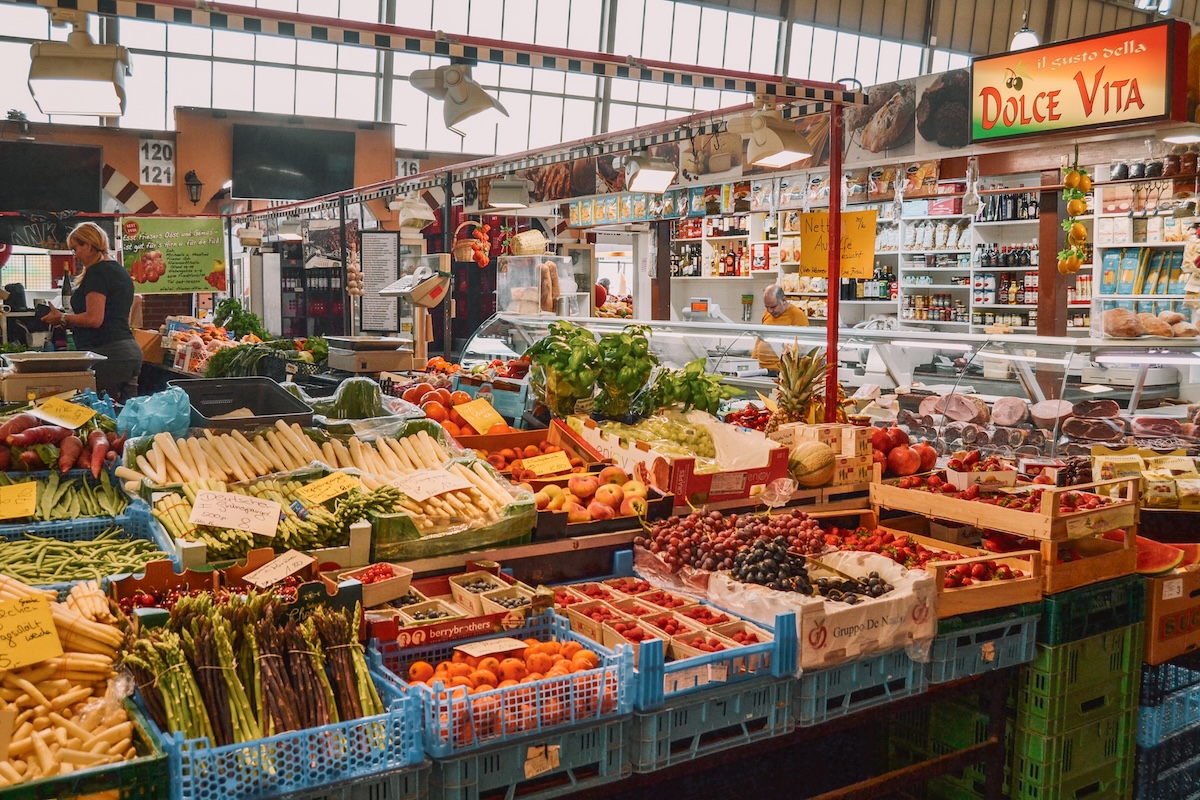
The Small Market Hall first opened in 1879 and now houses a variety of stands selling fresh produce, dried fruit and nuts, tea, fresh meats and fish, and so much more.
There are a few (not many!) stalls selling basic but delicious grab-and-go meals like falafel wraps. Note that there are additional stands along the mezzanine level, so be sure to head upstairs after you’ve scoped out the ground floor.
Hauptwache (Main Guard Room Square)
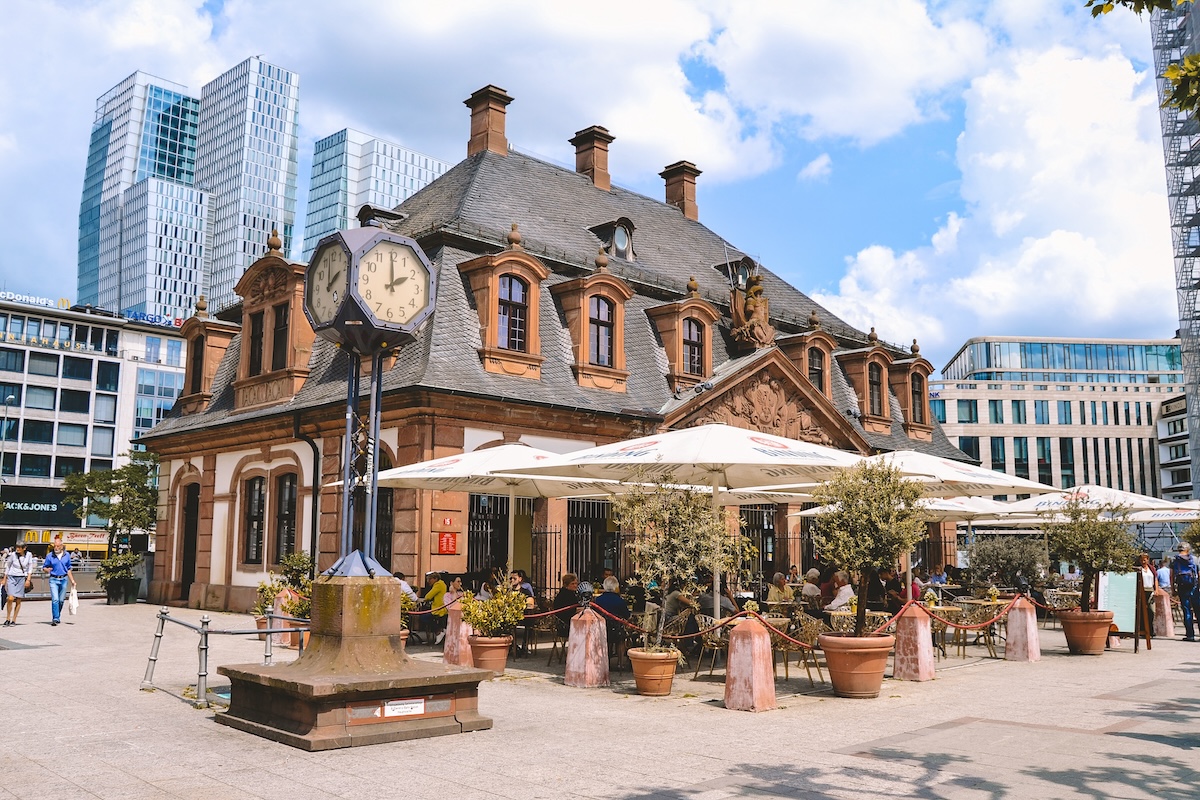
After the Römerberg, the Hauptwache is undoubtedly the prettiest square in Frankfurt!
The Baroque-style guardhouse in the center of the square was completed in 1731. It’s been used as a cafe since 1904 and is an excellent place to order a midday pick-me-up and watch the world go by.
Goethe-Haus (Goethe’s Birthplace)
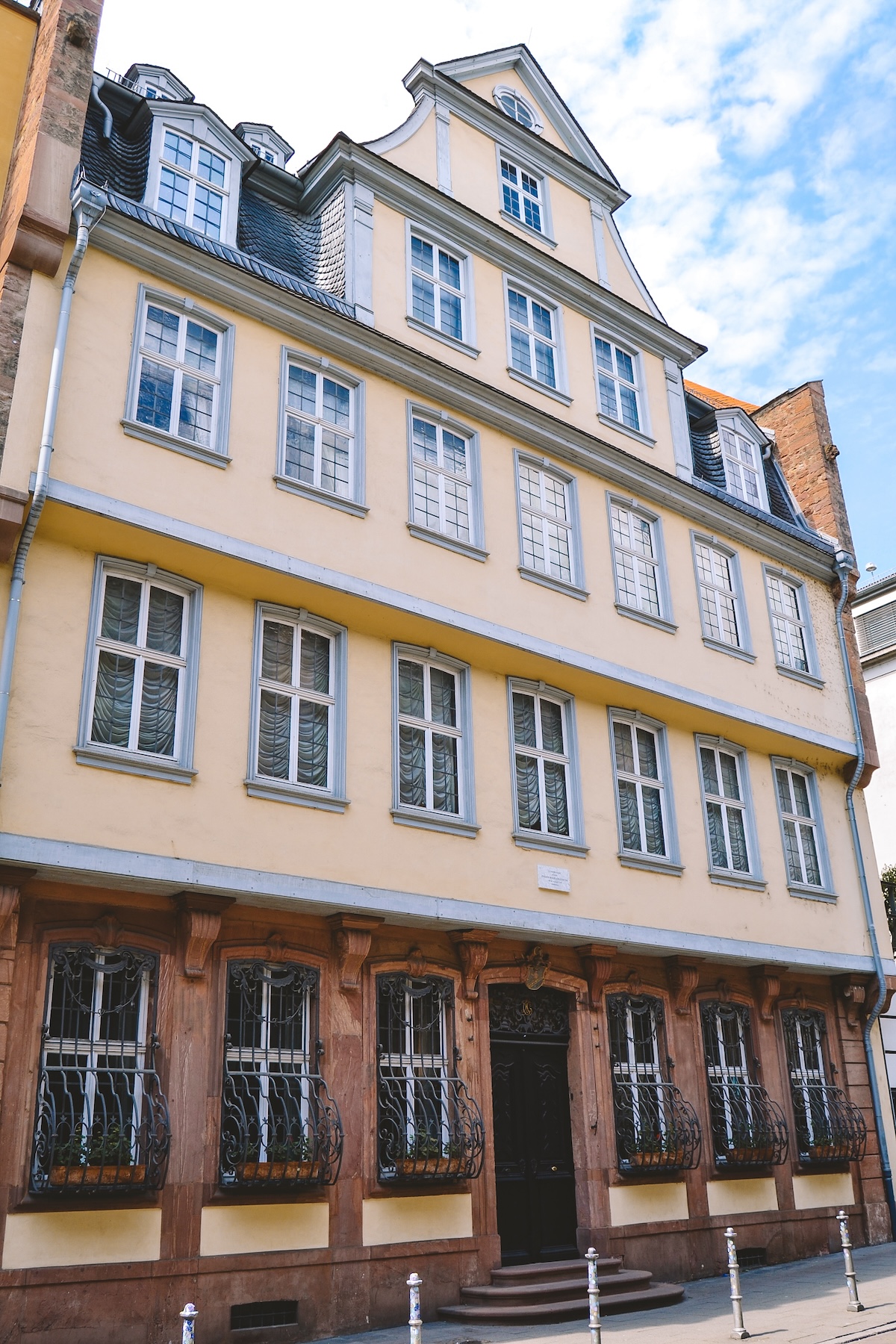
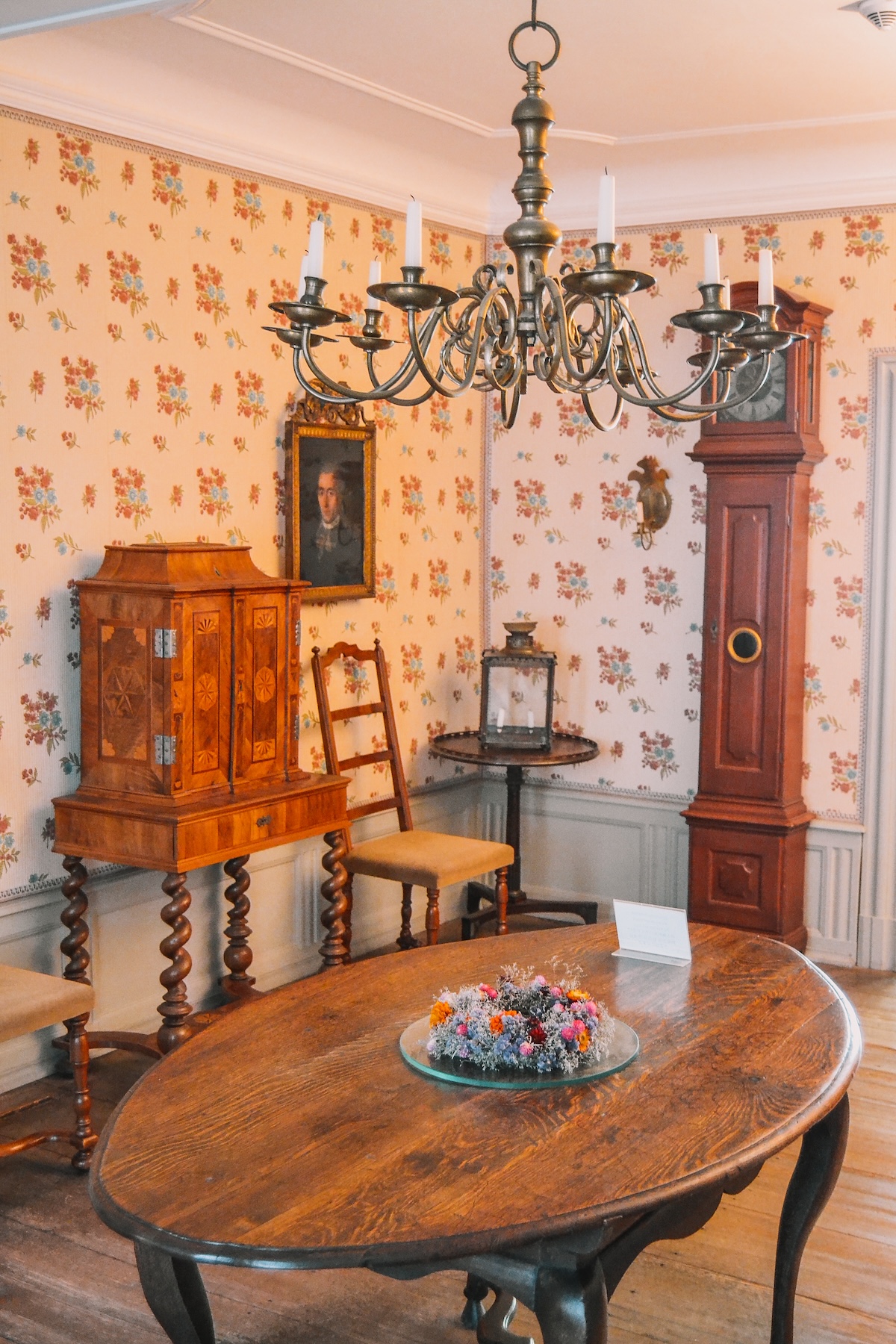
Born in Frankfurt am Main in August 1749, Johann Wolfgang von Goethe is considered to be Germany’s most famous writer. He produced such works as Faust and The Sorrows of Young Werther, but while he was alive he was also a well-known philosopher, scientist, and statesman.
To learn more about Goethe’s life in Frankfurt, I highly suggest touring his birthplace and childhood home on Großer Hirschgraben. He lived here until 1775, when he was invited to Weimar by Duke Karl August (read more about Goethe’s life in my detailed guide to Weimar).
Give yourself about 90 minutes to go through Goethe’s birthplace room by room. You’ll learn about the writer’s early life, as well as Frankfurt as a whole in the mid-1700s.
Claire’s Tip: Your ticket also grants you access to the German Romanticism Museum, which is attached to Goethe’s Birthplace. It’s a compact multimedia museum that focuses solely on the Romantic era.
Museums in the New Old Town
Additional points of interest in Frankfurt’s New Old Town are its many museums. Below are the main museums you should know about:
- Historical Museum Frankfurt — A museum dedicated to Frankfurt’s long and fascinating history.
- German Romanticism Museum — A multimedia museum dedicated to the Romantic Era. It’s attached to Goethe’s Birthplace, and your ticket grants you access to both sites.
- Frankfurt Archaeological Museum — Explores Frankfurt’s early history, from the Neolithic through Early Modern periods. If you’re particularly interested in learning about the city’s Roman or Carolingian history, come here!
- Caricatura (Museum for Comic Art) — Focuses on the illustrations produced by the New Frankfurt School, which was originally founded by former staff members of the satirical magazine pardon.
Seasonal Activity: Visit the Christmas Market
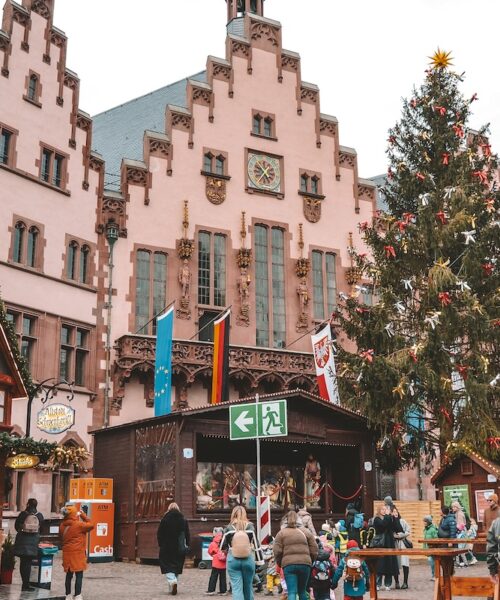
The Frankfurt am Main Christmas market takes over much of the Old Town and city center come December.
Be sure to read my full guide on what to do and eat at the Frankfurt Christmas market if you’ll be in the area during Advent!
Where to Eat in the New Old Town
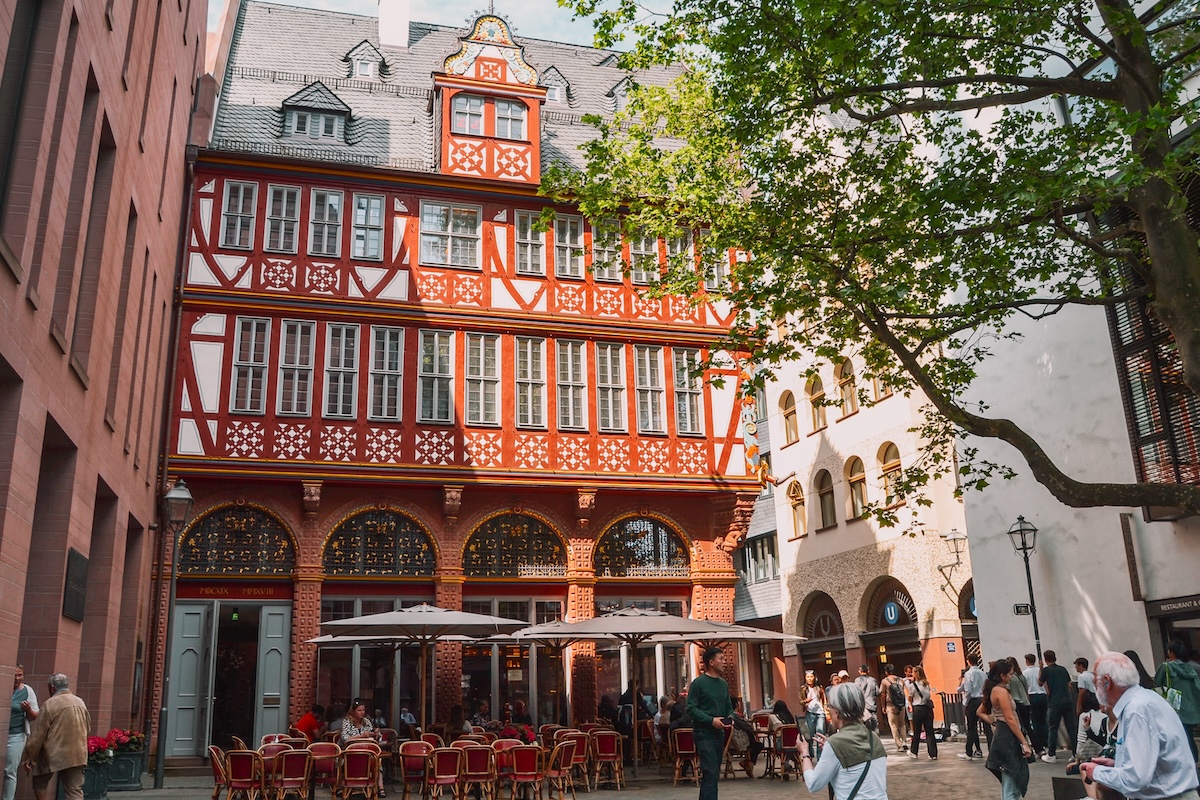
- Café Hauptwache (An der Hauptwache 15) — Classic German food in the city’s central square.
- Kaffeehaus Goldene Waage (Markt 5) — A stunning cafe rebuilt based on plans from the 17th century. There’s no prettier palace in Frankfurt’s New Old Town to indulge in a mid-day cake and coffee break.
- Paulaner am Dom (Domplatz 6) — Hearty Bavarian fair near the cathedral.
- Kleinmarkthalle (Hasengasse 5-7) — A covered market hall with lots of stalls selling fruits, vegetables, nuts, cheeses, meats, etc. There are a few stalls selling full meals like wraps.
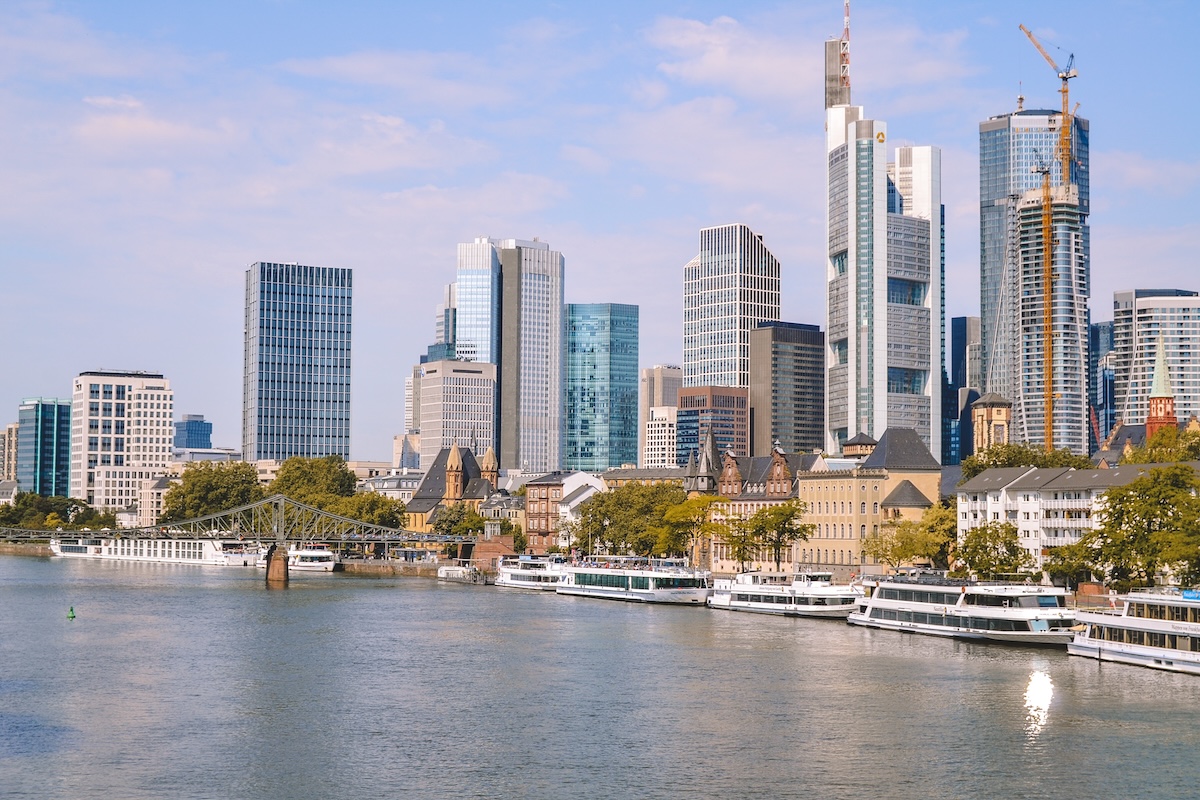
Where to Stay in the New Old Town
There are many great hotels in Frankfurt, but if you’re visiting specifically to explore the New Old Town and city center, I suggest booking a room at one of the following:
- Motel One Frankfurt-Römer (located within the Old Town)
- Paulaner am Dom Hotel (located within the Old Town)
- The Doorman Goethe (5-minute walk to the Römerberg)
- ibis Styles Frankfurt City (near the central train station; 15-minute walk to the Römerberg)
- Hilton Garden Inn Frankfurt City Centre (near the central train station; 15-minute walk to the Römerberg)
Otherwise I suggest searching Booking.com for a hotel in Frankfurt that fits your budget.
Bis zum nächsten Mal, Frankfurt!
Now that you know what to see in Frankfurt am Main’s Old Town, I hope you’ll plan a visit the next time you’re in western Germany!
Frankfurt is so well known for being the country’s financial center that it seems to remain somewhat of a “hidden gem” for tourists.
If you have any questions about the attractions mentioned in this guide, leave me a comment below!
Don’t forget to follow me on Instagram to keep up with my daily adventures in Berlin and beyond!

Leave A Reply!